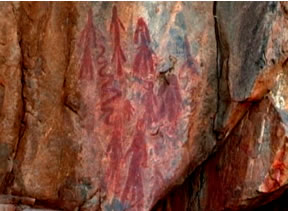
Introduction:
Would
you like your history to be ‘set in stone?’ The
indigenous people of Australia have been recording their history
and culture for 10,000 years! Investigate rock art to connect Australia’s
past to its present.
Societies'
connections to the past and present, the people and their interactions
with the land, are often visualized through art. Creative expression
and the use of visual imagery often speaks louder than words, drawing
upon aesthetic beauty to paint a cultural picture. The Aboriginal
societies used their artistic skills to create colorful images of
their ceremonies, rituals, and sacred paintings based on the Dreaming
or 'creation'. Supernatural ancestors such as Rainbow Serpent, the
Lightning Men, and Wandjina come to life as they struggle with earth's
natural features. Artwork may investigate a ‘Dreaming’
which relates to a person, animal, or geographic region.
This
extraordinary rock art is a mixture of Aboriginal lifestyle, culture,
and spirituality. It is found throughout the continent and displayed
in a wide variety of styles and techniques. Rock art has been the
most enduring form of art due to the materials used to create it.
And, what better way to preserve a work of art! Create it with lasting
materials such as rock walls for a ‘canvas’ and paints
from the earth. Display it in a protected environment away from
sun, wind and weather, such as in a cave and 10,000 years later,
there is a masterpiece waiting to be discovered!
 |
Aboriginal
history is recorded on rock faces, often tying the theme of the
clan ‘Dreamtime’ or origins to the mythical creatures
that represent the clan. Clans thought of themselves as being half
human and half mythical creatures. These mythical beings were linked
to the animal world, hence the use of symbols depicting emus, gowannas,
and wallabies. Rock art depicting human figures with pythons would
indicate they were part of the python clan or ‘Python Dreaming’.
Vocabulary:
- ochres
- Dreaming
or Dreamtime
- mythical
- imagery
- aesthetic
- abstract
Materials:
- earthtone
acrylics
- examples
of cave art (resource material)
- pictures
of animals
- flat,
smooth rocks, two inches diameter
- journals,
pencils
Preparation:
- Research
various designs in rock art from around the world
- In
journals, record several designs of rock art figures that have
special meaning; discuss why these particular designs might have
been important to the artists.
- Locate
an assortment of round, smooth stones, as might be found in a
creekbed, making sure they are free from dirt. The stones may
be from two to three inches in diameter.
- Sketch
a figure that is important, i.e., an animal symbol or nature symbol
that has meaning for the student.
- Select
paint colors that would represent colors from the earth and would
have been available to indigenous people, i.e., shades of reds,
tans, black, white
Procedure:
- Clean
the rock surface so that it is free from dirt or sand, then apply
a coat of acrylic paint to the rock surface.
- Simplify
the design of the animal pattern that you have selected.
- Transfer
the design to the rock surface after the base coat has dried;
select compatible colors of paint for the animal design (you may
use this technique to create a series of up to five rock art designs.
- Locate
a suitable container in which to place your rock art (as the container
will be buried, but not unearthed, the material of the container
should be biodegradable).
- Select
a location in which to bury the rocks; the class collection may
be buried in one location.
Analyze
and Conclude:
- Describe
the significant meaning of rock art to the people that created
it; list the special animals to the people and the events in their
daily lives.
- Describe
in journals why ‘rock art’ has significance.
- Identify
locations for rock art around the world. Why were these locations
suitable for the paintings to exist for 10,000 years?
- Rock
art samples should represent special things to you; record in
journals why these symbols are significant.
- Describe
how the rock art you buried will tell a story of your life to
its ‘discoverer’ 10,000 years in the future.
Management
Tip: use the print feature
in your browser to print this page.
|
